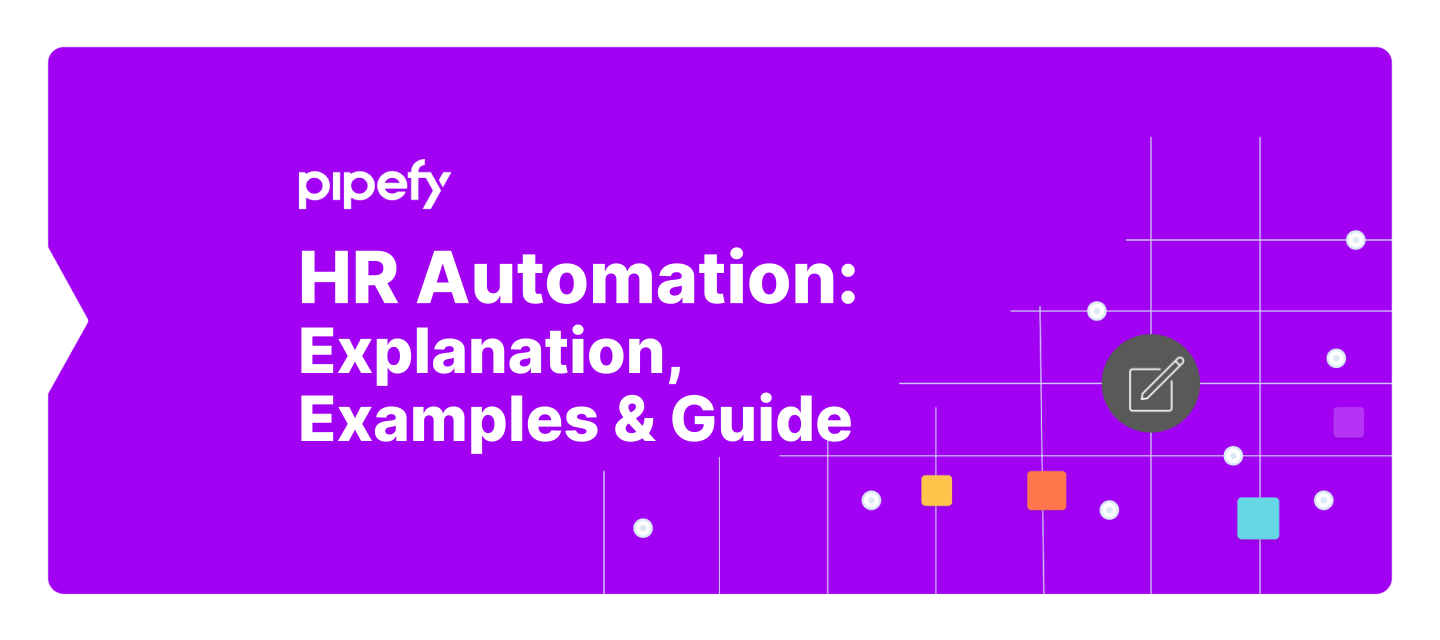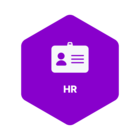HR automation makes candidate and employee journeys more human by eliminating repetitive tasks and giving teams more face time.
HR automation improves employee experiences and increases process efficiency by eliminating repetitive tasks, reducing workload, and creating faster processes. That means people operations teams (including HR and TA) have more time to take care of candidates and employees.
What is HR automation?
Human resources automation refers to the use of apps and software to complete HR tasks and activities with little or no human input. Tasks that can be automated include those that occur frequently and activities that do not require complex decision making skills.
HR automation is sometimes referred to as HR process automation, HR workflow automation, or even HR digitization. While they may sound similar, the way automation affects tasks is nuanced. Below is a quick glance at the differences:
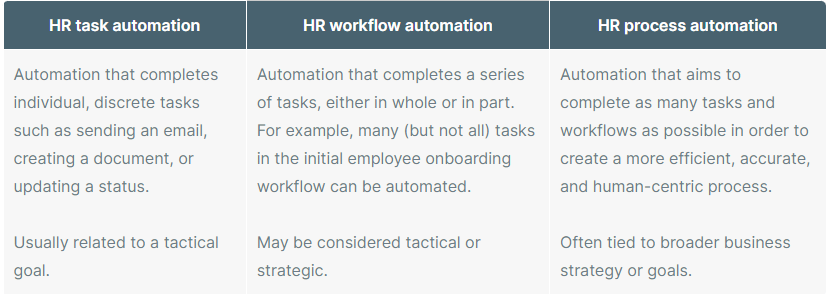
Why is HR automation important?
Automation makes sense for HR teams for one simple reason: the less time they spend on repetitive, manual, or supporting administrative tasks, the more face time they have with people.
HR teams that use process automation create better candidate and employee experiences, respond to requests more quickly, and see greater accuracy and efficiency in their work. Automation also makes it easier for HR teams to deliver data and insights that help drive business strategy or achieve total HR digital transformation.
The average HR professional saves 8 hours of work each week with automation.
Zapier: “Marketers Lead the Pack in Automation at Work.”
7 benefits of HR automation
HR process automation improves the overall candidate and employee experience. That’s because automation eliminates repetitive or support tasks and gives HR, People Ops, and TA teams more time to focus on people, improve HR service delivery, and help them solve problems quickly, efficiently, and error-free.
Here are 7 primary benefits of automating HR processes:
1 – Faster response times
Automation keeps employee requests and work items moving along by routing items to the correct person, updating statuses, and sending alerts when items approach a deadline or have been idle for too long. Automation also captures requests from email or chat, and initiates the workflow without any additional effort from you or your team.
2 – Easier collaboration, less friction
Problems with handoffs and delays in communication are common with a high volume of employee requests and work items. The trouble is exacerbated by workflows that require input or action from team members in other departments. HR automation software makes it easy to route items to the right person — in any department — so they can provide feedback, approvals, or status updates.
3 – Fewer errors
HR automation software reduces dependency on manual data entry, which minimizes opportunities for errors. It also unifies data across departments, apps, and platforms to provide more consistent records while eliminating the need for repeated data entry.
4 – Improved visibility
Employees, team members, and managers all feel better when they can see the status of their requests and work items. HR automation tools can update statuses based on time, input, or assignee. Users can view the status of all their items from a single dashboard or kanban view so they know exactly where every item stands.
5 – Deeper HR data insights
Business strategy precision depends on accurate data and actionable insights from the HR team. Reports and dashboards that illustrate key metrics and KPIs are built into HR automation software so that data is always organized and ready to be presented at the leadership table.
6 – More efficient workflows
HR teams spend less time completing repetitive or redundant tasks such as sending emails, entering data, and manually routing or updating requests and work items. Time recovered from these tasks can be redirected toward more value-producing activities. Efficiency also means that employee requests are resolved faster.
7 – Better employee experiences
HR automation creates a seamless user experience across all stages of the candidate and employee lifecycle. Self-service features allow users to instantly access documents and information, as well as submit new requests or check on the status of those in progress.
What kinds of HR tasks can be automated?
The point of HR process automation isn’t to create sterile or robotic processes in which candidates and employees have zero human interaction. In fact, the opposite is true: automation makes HR processes more human.
In order to automate HR processes, we need to distinguish between two kinds of activities: those that need to be done by people, and those that do not. If the task doesn’t have to be done by a person, then it should be automated. These kinds of tasks usually share at least one of the following characteristics:
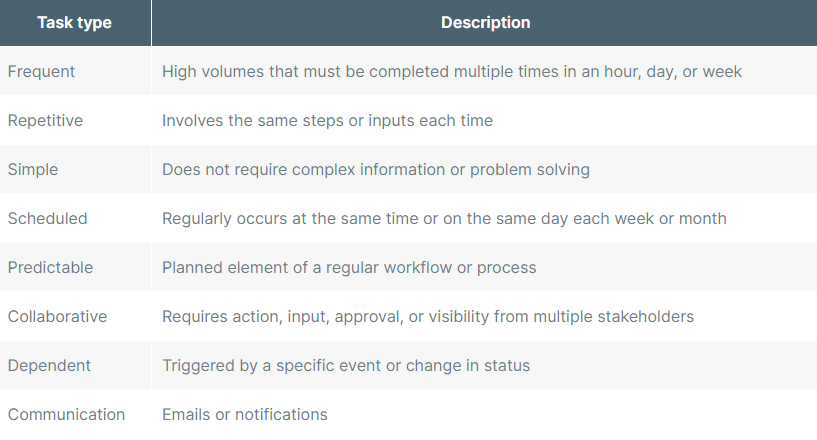
However, even when there are activities that require human interaction — such as communication, collaboration, and problem solving — there is still opportunity for automation.
For example, in a typical employee onboarding workflow, there are several touchpoints that need to be done by someone in the HR team, including:
1 - Reaching out to new hires to welcome them aboard
2 - Leading orientation meetings
3 - Answering questions & addressing concerns
4 - Helping new hires with any incidental issues that arise
5 - Creating schedules
While these tasks rely on people, these same activities also require a lot of repetitive and supporting tasks that can be automated, such as:
1 - Creating and sending welcome letters
2 - Delivering notifications
3 - Updating statuses
4 - Capturing signatures
5 - Routing paperwork to the right department
6 - Sending calendar invites
For teams with large workforces, or businesses planning to scale recruitment efforts, automating these kinds of tasks can make a huge difference in terms of workload for the HR team and creating a positive employee experience. When paired with integration, the number and types of tasks that can be automated increases.
HR automation examples
Most of the workflows and processes an HR team manages can be automated in whole or in part. Below are some examples of automated HR workflows that can be easily managed with software.
Recruiting & talent acquisition

The job market in the U.S. remains highly competitive, so talent acquisition teams and recruiters need every advantage they can leverage if they want to land the best and brightest candidates.
Automation makes the recruitment process faster, and also makes it more meaningful for both the recruiter and the candidates. That’s because TA specialists have more time to expand their talent pool, zero in on the right candidates, and build relationships that result in hiring the right candidate.

Employee onboarding
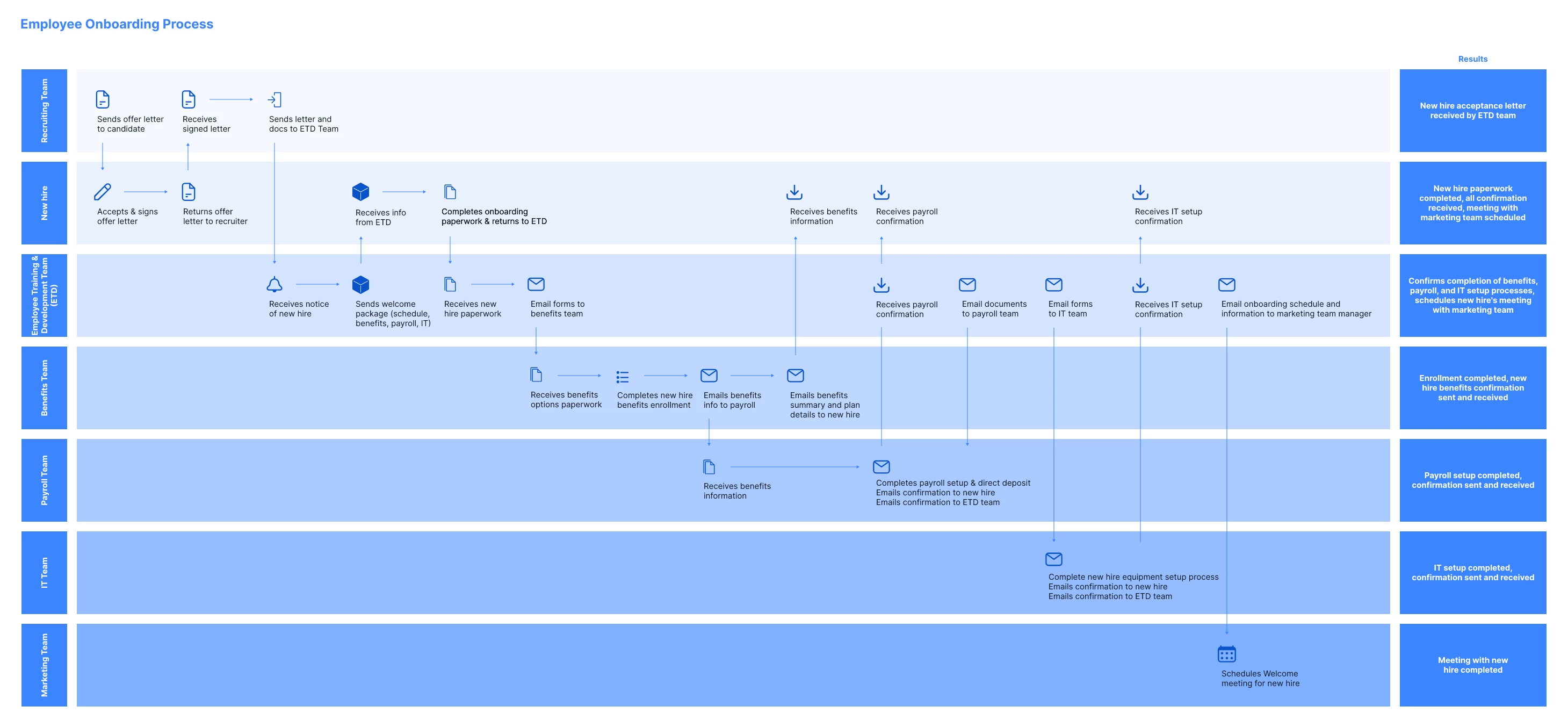
Employee onboarding is one of the most complex workflows any HR team has to manage. Once a candidate transitions into new hire status, several interrelated workflows get underway. For example, scheduling initial training, setting up payroll and benefits, issuing equipment, and IT requirements must all happen at about the same time. The scope of the onboarding process — and all the collaboration it requires — makes it a prime candidate for automation.

HR case/employee request management
HR teams field a wide range of HR cases and employee requests. What makes request management complicated is that every type of request may require its own workflow. Each requires input from collaborators in different departments, so no two request types are resolved in exactly the same way.
HR automation software with a simple drag-and-drop interface makes it easy for HR teams to visualize and orchestrate workflows so that every type of request/case is received, routed, and resolved without friction and as quickly as possible.

HR process automation: A 5-step framework
For teams considering automating their HR processes, the good news is that the tools available today make it relatively easy to accomplish. Below is a five-step framework for building automated HR workflows:
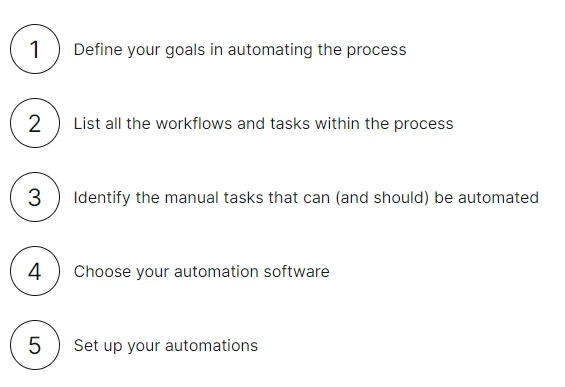
1 – Define your automation goal(s)
Clearly defining what your company or team wants to achieve through automation will help you identify the right tasks to automate and select the most appropriate automation tool. Specific metrics (such as time-to-hire, time-to-resolution, or workflow capacity) can be tracked through reports and dashboards.
2 – List your workflows and related tasks
For each process that you want to automate, create an inventory of each step, task, and activity. Make sure you understand the boundaries of each individual workflow, what signal or action begins the workflow, and the desired outcome. Any activity that takes place between these two boundaries should be listed.
3 – Identify your target automations
Divide your completed inventory into two groups: items that should be handled by a person, and items that do not require human input. This second group will be your target automations. Make sure to note any items that are particularly time consuming or have to be completed manually or with spreadsheets.
4 – Choose your automation software
Workflow automation tools vary in terms of their features and flexibility. What ‘s most important for teams to consider is scalability and ease-of-use.
Even though the initial focus of automation may be HR workflows, those workflows intersect with other teams and departments. A workflow automation tool should be able to seamlessly connect workflows across teams and departments to make collaboration easier and to provide a single, consolidated source of information.
HR workflows are also subject to change. Recruitment/onboarding efforts ebb and flow, the volume and complexity of employee requests varies, and teams often revise their workflows to make processes more efficient. Your workflow automation tool needs the elasticity to easily adapt to these changes. An easily customizable platform with a drag-and-drop menu can make it simple to modify workflows when needed, without having to wait on your IT team.
5 – Configure your automation(s)
Setting up an HR workflow and automating should be simple and straightforward. Drag-and-drop interfaces allow anyone with permission to quickly build workflows and set up automations. Some HR automation software also provide templates for each workflow. Templates provide instant access to workflow structures, and each template can be customized with just a few clicks.
Essential HR workflow software features
A key step in successfully improving a process with automation relies on choosing the correct software. People teams looking for tools to help manage their workflows have a lot of choices when it comes to the software they use. Each type of software varies in terms of the features it includes, so it’s important for teams to understand all of the options.
These features can be grouped into three categories: features that improve the candidate/employee experience, features that help HR professionals and people teams manage their workflows, and features that help drive overall business strategy. Below is breakdown of essential features to look for:
1 – Features that improve employee/candidate experiences
One of the primary goals for any people team is delivering better experiences throughout the employee and candidate journey. That means the automation software needs to be user friendly and people-focused. Here are some examples of HR automation features that candidates and employees will love.
Self-service portals that empower employees
Empowering employees to help themselves can go a long way to improving their experience. One of the ways HR workflow software can do this is by providing instant access to information and documents. Centralizing this information — along with request submission — into a single portal reassures employees (and candidates) by giving them a greater sense of access and control.
Multiple views that deliver total visibility
Candidates want to see how their applications are progressing. New hires want to understand how the onboarding journey will unfold. Employees want to know the status of their requests. All users have access to calendar and Kanban views that show them exactly how their requests are progressing and what to expect next. This level of visibility builds trust by sending automated notifications and letting employees check on case/request statuses at their convenience.
Automations that speed up time-to-resolution
Time-to-resolution plays a central role in job satisfaction and employee experience. Automation keeps HR cases and requests moving along by updating statuses and alerting stakeholders when items are approaching a deadline, or when they have remained in the same status too long. Automating emails and data entry further speed up the workflow.
2 – Features that help people teams
HR process automation builds better experiences for candidates and employees, but it also makes life easier for recruiters, TA specialists, HR professionals, and everyone else on your people team. Look for software that is easy to use, integrates easily with existing applications, and which simplifies HR request management.
Simple automation set-up
Reduce the amount of time spent on repetitive and supporting tasks by automating activities that don’t require a human touch. That means more face time with candidates and employees, and faster time to resolution for HR cases. Automation should be easy to set up and should integrate with existing tools. Learn more about HR automation software.
Drag-and-drop interface
Workflow complexity and request volume change over time. Software should make modifying workflows a snap so that anyone with permission can update existing workflows or create new ones with ease. A drag-and-drop interface simplifies workflow changes and alleviates the IT bottleneck.
Integration that builds a seamless use experience
Most HR teams rely on a toolbox of apps for recruiting, onboarding, request management, payroll, and all the other processes they manage. Workflow automation software should be able to integrate with other tools to eliminate duplicate data entry, centralize information, and provide a seamless user experience
Forms that simplify request management
People teams deal with a wide range of employee requests. These include requests for PTO, changes to payroll, benefits enrollment, requests for documents, and reimbursements. Using a rules-based forms feature ensures that requests always include all the necessary information. Automation then routes each request to the appropriate person.
3 – Features that help HR drive business strategy
Another important way that HR automation can help people teams is by organizing complex information for analysis and planning. Look for software options that include easily customizable dashboards and reports.
Dashboards for instant insights
HR data plays a critical role in shaping business strategy. In order for it to do that, teams need fast access to vital metrics such as average time-to-hire, total open positions, onboarding statuses, and recruitment activity. They also need ways to identify bottlenecks and workflow issues so they can be addressed.
Workflow automation software should provide customizable dashboards that can provide instant, actionable insights that can be easily shared at the leadership table.
Reports that enable data analysis and decision making
HR workflows capture and generate a lot of data. Mining that data to find patterns, calculate costs, and ultimately make decisions depends on having easy access. HR automation software should make it easy to consolidate information and create custom reports that can shape business strategy and help leaders make informed decisions.
HR automation: better employee experiences through unified workflows
The need for people teams to deliver exceptional experiences has taken on new urgency in the wake of the COVID-19 pandemic and the Great Resignation.
Both recruitment and retention depend on a company’s ability to shift their focus from processes to people. HR automation is one tool that teams can use to improve the candidate/employee journey, and make their work easier at the same time.With Pipefy, you can implement key features and benefits that support and uplift teams, employees, and candidates.

